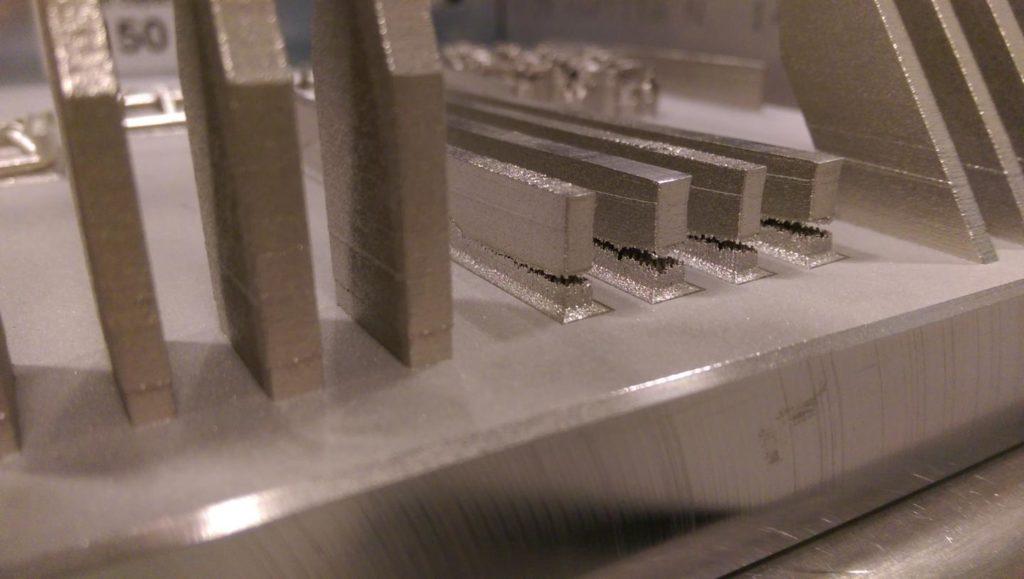Quality control has long been the Achilles heel of metal 3D printing. This is particularly true for metal powder bed fusion (PBF), where countless variables interact to make the process difficult to predict and manage. While companies like VELO3D have taken it upon themselves to implement active quality control mechanisms within their own 3D printers, there has yet to be an industry-wide solution. Now, Sigma Labs, Inc. (NASDAQ: SGLB) and Materialise (NASDAQ: MTLS), have announced a new platform that combines their respective tools to introduce in-process quality control into metal PBF 3D printers.

PrintRite3D 7.0: 3D Volume Workspace; Anomalies shown in red
The new product package combines the Materialise Control Platform (MCP) and Sigma Labs’ PrintRite3D sensor technology so that machine operators can pick out and fix print jobs in real time. This makes it possible to achieve the necessary consistency and repeatability necessary for large batch production. With the ability to intervene and correct a build, it’s possible to achieve the proper part with fewer errors, thus reducing waste and improving machine throughput.
Generally, 3D printing metal parts is a complex mess, with every variable impacting the outcome of a print job. The geometry of the part, as well as its orientation on the build platform and the placement of support structures affect the success of a print. This is combined with the material from which the component is made, the laser scan pattern, spot size, and the level of gas in the build chamber. If even one of these parameters is off, a part may experience cracks and warping that not only result in a failed build but can damage the machine itself.

Here, stress buildup shows the collapse of four metal bars created through additive manufacturing. Image courtesy of Albert To / University of Pittsburgh’s Swanson School of Engineering.
To tackle the problem of quality control in metal 3D printing, we’ve seen a variety of products. For instance, simulation software from the likes of ANSYS make it possible to pre-warp 3D printed parts to compensate for warping. Sensor systems from printer manufacturers and/or third parties like Sigma Labs and Additive Assurance can be used to gain greater control over the process. This can also help companies qualify parts for aerospace and medical applications, as information picked up with these sensors can be used for certification purposes. So far, however, this has been limited to minor failsafe mechanisms and data gathering.

The MCP eocsystem. Image courtesy of Materialise.
With this combined solution, operators are given a method for actually stepping in and correcting issues as they arise. MCP can manage more than 250 parameters and up to 16 lasers, with PrintRite3D, in this case, providing the data collection for the Materialise software. Without PrintRite3D, MCP is available for selective laser sintering and stereolithography, as well.
“The platform we’ve developed eliminates one of the most common roadblocks for manufacturers interested in using metal additive manufacturing for serial production,” said Materialise CTO Bart van der Schueren. “The platform is open and flexible allowing manufacturers to take control of their specific processes to fit their unique applications. This makes it possible for customers to leverage their expertise and truly take advantage of the customization and localization benefits that AM provides.”
Mark Ruport, President and CEO of Sigma Labs, stated, “I am very pleased with our long relationship with Materialise and the close collaboration between our engineering teams. We believe the combination of the Materialise Control Platform with Sigma’s real-time melt pool monitoring, and analytics software has created a significant breakthrough in the additive manufacturing industry. I look forward to future opportunities to collaborate and find ways to continue to improve the quality and consistency of 3D metal printing as more companies go into production in the coming years.”
From the sound of it, intervention is currently a manual process. Therefore, the next stage will be some sort of active quality control system. In the meantime, Materialise offers training for its MCP. The two companies are also aiming to work with end users and machine manufacturers to tailor the package for their specific applications and equipment. So, we are still steps away from the levels of automation anticipated by the “Automation, Additive Manufacturing and the Factory of the Future” report from SmarTech Analysis. However, automated in-process quality control will be a, if not the, crucial development necessary for lights-out additive manufacturing.
Subscribe to Our Email Newsletter
Stay up-to-date on all the latest news from the 3D printing industry and receive information and offers from third party vendors.
You May Also Like
Further Understanding of 3D Printing Design at ADDITIV Design World
ADDITIV is back once again! This time, the virtual platform for additive manufacturing will be holding the first-ever edition of ADDITIV Design World on May 23rd from 9:00 AM –...
3D Printer Maker EVO-tech Reborn as NEVO3D — Once More With Feeling
EVO-tech was a 3D printing service and original equipment manufacturer established in 2013 and based in Schörfling am Attersee, Austria. The company produced high-quality material extrusion systems featuring linear bearings,...
3D Systems Brings 3D Printed PEEK Cranial Implant to the U.S. with FDA Clearance
For more than 10 years, 3D Systems (NYSE:DDD) has worked hand-in-hand with surgeons to plan over 150,000 patient-specific cases, and develop more than two million instruments and implants from its...
CDFAM Returns to Berlin for Second Annual Symposium
The second CDFAM Computational Design Symposium is scheduled for May 7-8, 2024, in Berlin, and will convene leading experts in computational design across all scales. Building upon the first event...































